Recognising Mineral Deposits from Cover; A Case Study Using Zircon Chemistry in the Gawler Craton, South Australia
Abstract
1. Introduction
2. Background
Exploration through Cover
3. Materials and Methods
3.1. Sample Selection and Preparation
3.2. Whole-Rock Geochemical Analysis
3.3. Zircon U–Pb Geochronology and Geochemistry
4. Results
4.1. Sample Descriptions
4.2. Whole-Rock Geochemistry
4.3. Zircon Morphology
4.4. Zircon U–Pb Analysis
4.5. Zircon Chemistry
5. Discussion
5.1. Origin of Zircon within the Basal Diamictite
5.2. Zircon Chemistry in the Clasts
5.3. Zircon Chemistry in the Matrix
5.4. Exploration Criteria Using Zircon in Cover Sequence Materials
5.5. Zircon Criteria Applied to Whole-Rock Geochemistry
5.6. Future Potential
6. Conclusions
Supplementary Materials
Author Contributions
Funding
Data Availability Statement
Acknowledgments
Conflicts of Interest
References
- Kyser, K.; Barr, J.; Ihlenfeld, C. Applied Geochemistry in Mineral Exploration and Mining. Elements 2015, 11, 241–246. [Google Scholar] [CrossRef]
- Schodde, R. Long term trends in global exploration—Are we finding enough metal? In Proceedings of the 11th Fennoscandian Exploration and Mining Conference, Levi, Finland, 31 October 2017. [Google Scholar]
- Anand, R.R. Evolution, classification and use of ferruginous regolith materials in gold exploration. Yilgarn Craton, Western Australia. Geochem. Explor. Environ. Anal. 2001, 1, 221–236. [Google Scholar] [CrossRef]
- Baudet, E.; Giles, D.; Tiddy, C.; Hill, S. Evaluation of cover sequence geochemical exploration sample media through assessment of element migration processes. Ore Geol. Rev. 2018, 102, 449–473. [Google Scholar] [CrossRef]
- Baudet, E.; Tiddy, C.; Giles, D.; Hill, S.; Gordon, G. Diverse provenance of the Lower Cretaceous sediments of the Eromanga Basin, South Australia: Constraints on basin evolution. Aust. J. Earth Sci. 2020, 68, 316–342. [Google Scholar] [CrossRef]
- Forbes, C.; Giles, D.; Freeman, H.; Sawyer, M.; Normington, V. Glacial dispersion of hydrothermal monazite in the Prominent Hill deposit: An exploration tool. J. Geochem. Explor. 2015, 156, 10–33. [Google Scholar] [CrossRef]
- Plouffe, A.; Ferbey, T.; Hashmi, S.; Ward, B.C. Till geochemistry and mineralogy: Vectoring towards Cu porphyry deposits in British Columbia, Canada. Geochem. Explor. Environ. Anal. 2016, 16, 213232. [Google Scholar] [CrossRef]
- Wolff, K.; Tiddy, C.; Giles, D.; Hill, S.M. Pedogenic carbonate sampling for Cu exploration on the Yorke Peninsula, South Australia. J. Geochem. Explor. 2018, 194, 239–256. [Google Scholar] [CrossRef]
- Salama, W.; Anand, R.R.; Verrall, M. Mineral exploration and basement mapping in areas of deep transported cover using indicator heavy minerals and paleoredox fronts, Yilgarn Craton, Western Australia. Ore Geol. Rev. 2016, 72, 485–509. [Google Scholar] [CrossRef]
- Lu, Y.-J.; Loucks, R.R.; Fiorentini, M.; Mccuaig, T.C.; Evans, N.J.; Yang, Z.-M.; Hou, Z.-Q.; Kirkland, C.L.; Parra-Avila, L.A.; Kobussen, A. Zircon Compositions as a Pathfnder for Porphyry Cu ± Mo ± Au Deposits. Soc. Econ. Geol. Spec. Publ. 2016, 19, 329–347. [Google Scholar]
- Plavsa, D.; Tidyy, C.J. Characterisation and dispersion of hydrothermal monazite related to iron oxide-copper-gold mineralisation in South Australia. Future Ind. Accel. (FIA) Rep. 2018, in press. [Google Scholar]
- Porter, T.M. The Carrapateena Iron Oxide Copper Gold Deposit, Gawler Craton, South Australia: A Review. In Hydrothermal Iron Oxide Copper-Gold and Related Deposits: A Global Perspective, v. 3—Advances in the Understanding of IOCG Deposits; Porter, T.M., Ed.; PGC Publishing: Adelaide, Australia, 2010; pp. 91–120. [Google Scholar]
- Reid, A. The Olympic Cu–Au Province, Gawler Craton: A Review of the Lithospheric Architecture, Geodynamic Setting, Alteration Systems, Cover Successions and Prospectivity. Minerals 2019, 9, 371. [Google Scholar] [CrossRef]
- Tiddy, C.; Giles, D. Suprasubduction zone model for metal endowment at 1.60–1.57 Ga in eastern Australia. Ore Geol. Rev. 2020, 122, 103483. [Google Scholar] [CrossRef]
- Brotodewo, A.; Tiddy, C.J.; Zivak, D.; Fabris, A.; Giles, D. Zircon U-Pb and trace element chemistry of Donington Suite granites associated with Iron Oxide Copper Gold Deposits in the Gawler Craton, South Australia. Econ. Geol. in review.
- Pizarro, H.; Campos, E.; Bouzari, F.; Rousse, S.; Bissig, T.; Gregoire, M.; Riquelme, R. Porphyry Indicator Zircons (PIZs): Application to exploration of Porphyry Copper Deposits. Ore Geol. Rev. 2020, 126, 103891. [Google Scholar] [CrossRef]
- Reid, A.J.; Jagodzinski, E.A.; Armit, R.J.; Dutch, R.A.; Kirkland, C.L.; Betts, P.G.; Schaefer, B.F. U–Pb and Hf isotopic evidence for Neoarchean and Paleoproterozoic basement in the buried northern Gawler Craton, South Australia. Precambrian Res. 2014, 250, 127–142. [Google Scholar] [CrossRef]
- Hayward, N.; Skirrow, R.G. Geodynamic setting and controls on iron oxide Cu–Au (U) Ore in the Gawler Craton, South Australia. In Hydrothermal Iron Oxide Copper–Gold and Related Deposits: A Global Perspective—Advances in the Understanding of IOCG Deposits; Porter, T.M., Ed.; PGC Publishing: Adelaide, Australia, 2010; Volume 3, pp. 119–146. [Google Scholar]
- Fairclough, M. Geological and metallogenic setting of the Carrapateena FeO–Cu–Au deposit—A PACE success story. MESA J. 2005, 38, 4–14. [Google Scholar]
- Reid, A.; Hand, M.; Jagodzinski, E.; Kelsey, D.; Pearson, N. Paleoproterozoic orogenesis in the southeastern Gawler Craton, South Australia. Aust. J. Earth Sci. 2008, 55, 449–471. [Google Scholar] [CrossRef]
- Sawyer, M. Carrapateena and nearby exploration discoveries. In Proceedings of the South Australian Exploration and Mining Conference, Adelaide, Australia, 25 November–3 December 2013. [Google Scholar]
- Gow, P.A.; Wall, V.J.; Oliver, N.H.S.; Valenta, R.K. Proterozoic iron oxide (Cu-U-Au-REE) deposits: Further evidence of hydrothermal origins. Geology 1994, 22, 633–636. [Google Scholar] [CrossRef]
- Apukhtina, O.B.; Kamenetsky, V.S.; Ehrig, K.; Kamenetsky, M.B.; Maas, R.; Thompson, J.; Mcphie, J.; Ciobanu, C.L.; Cook, N.J. Early, deep magnetite-fluorapatite mineralisation at the Olympic Dam Cu-U-Au-Ag deposit, South Australia. Econ. Geol. 2017, 112, 1531–1542. [Google Scholar] [CrossRef]
- Ehrig, K.; Mcphie, J.; Kamenetsky, V. Geology and mineralogical zonation of the olympic dam iron oxide Cu-U-Au-Ag deposit, South Australia. Soc. Econ. Geol. Spec. Publ. 2012, 16, 237–267. [Google Scholar]
- Belperio, A.; Flint, R.; Freeman, H. Prominent Hill: A hematite-dominated, iron oxide-copper–gold system. Econ. Geol. 2007, 102, 1499–1510. [Google Scholar] [CrossRef]
- Drexel, J.F.; Preiss, W.V. The geology of South Australia. S. Aust. Geol. Surv. Bull. 1995, 2, 357. [Google Scholar]
- Vella, L.; Cawood, M. Carrapateena: Discovery of an Olympic Dam-style deposit: Preview. ASEG Ext. Abstr. 2006, 122, 26–30. [Google Scholar]
- Mortimer, G.E. Early to Middle Proterozoic Granitoids, Basaltic Dykes and Associated Layered Rocks of S.E. Eyre Peninsula, South Australia. Ph.D. Thesis, University of Adelaide, Adelaide, Australia, 1984; 189p. [Google Scholar]
- Kleeman, A. The Petrology and trace Element Geochemistry of the Carrapateena Deposit, Olympic IOCG Province, South Australia. Honours Thesis, University of Tasmania, Hobart, Australia, 2012; 113p. unpublished. [Google Scholar]
- Lloyd, J.; Blades, M.; Counts, J.; Collins, A.; Amos, K.; Wade, B. Neoproterozoic geochronology and provenance of the Adelaide Superbasin. Precambrian Res. 2020, 350, 105849. [Google Scholar] [CrossRef]
- Preiss, W.V. (compiler); Adelaide Geosyncline–late Proterozoic stratigraphy, sedimentation, palaeontology and tectonics. In Bulletin 53; Geological Survey of South Australia: Adelaide, Australi, 1987. [Google Scholar]
- Tonkin, D. Recognition and definition of the copper-hosting Whyalla Sandstone, South Australia. MESA J. 2019, 89, 39–44. [Google Scholar]
- Vella, L.; Emerson, D.W. Carrapateena: Physical properties of a new iron-oxide copper-gold deposit. In Proceedings of the 20th International Geophysical Conference and Exhibition, Adelaide, Australia, 12 February 2009; Extended Abstracts. pp. 1–13. [Google Scholar]
- Tiddy, C.; Zivak, D.; Hill, J.; Giles, D.; Hodgkison, J.; Neumann, M.; Brotodewo, A. Monazite as an Exploration Tool for Iron Oxide-Copper-Gold Mineralisation in the Gawler Craton, South Australia. Minerals 2021, 11, 809. [Google Scholar] [CrossRef]
- Preiss, W.V.; Dyson, I.A.; Reid, P.W.; Cowley, W.M. Revision of lithostratigraphic classification of the Umberatana Group. MESA J. 1998, 9, 36–42. [Google Scholar]
- González-Álvarez, I.; Ley-Cooper, A.-Y.; Salama, W. A geological assessment of airborne electromagnetics for mineral exploration through deeply weathered profiles in the southeast Yilgarn Cratonic margin, Western Australia. Ore Geol. Rev. 2016, 73, 522–539. [Google Scholar] [CrossRef]
- González-Álvarez, I.; Boni, M.; Anand, R.R. Mineral exploration in regolith-dominated terrains: Global considerations and challenges. Ore Geol. Rev. 2016, 73, 375–379. [Google Scholar] [CrossRef]
- Anand, R.R. Regolith-landform processes and geochemical exploration for base metal deposits in regolith-dominated terrains of the Mt Isa region, northwest Queensland, Australia. Ore Geol. Rev. 2016, 73, 451–474. [Google Scholar] [CrossRef]
- Brown, L.; Vearncombe, J. Critical analysis of successful gold exploration methods. Appl. Earth Sci. Trans. Inst. Min. Metall. 2014, 123, 18–24. [Google Scholar] [CrossRef]
- Cameron, E.M.; Leybourne, M.I.; Kelley, D.L. Exploring for deposits under deep cover using geochemistry. Soc. Econ. Geol. Newsl. 2005, 63, 5–15. [Google Scholar]
- Cornelius, M.; Potto, C.G.; Dunn, C.E.; Butt, C.R.M.; Oates, C.; Coelho, R. Soil and biogeochemical signatures of the Aripuana base metal deposit, Mato Grosso, Brazil. Geochem. Explor. Environ. Anal. 2007, 7, 179–192. [Google Scholar] [CrossRef]
- Mcclenaghan, M.; Paulen, R. Application of Till Mineralogy and Geochemistry to Mineral Exploration. Past Glacial Environ. 2018, 689–751. [Google Scholar] [CrossRef]
- Anand, R.R.; Phang, C.; Wilford, J.; Wildman, J.E.; Li, S.; Robertson, I.D.M.; Munday, T.J. Regolith-Landscape Characteristics, Evolution and Regional Synthesis of the Mt Isa Region: Progress Report; Cooperative Research Centre for Landscape Evolution and Mineral Exploration: Wembley, Australia, 1996; Volume 125, pp. 35–38. [Google Scholar]
- Cameron, E.M.; Leybourne, M.I.; Kelley, D.L. Exploring for deeply covered mineral deposits: Formation of geochemical anomalies in northern Chile by earthquake-induced surface flooding of mineralised groundwaters. Geology 2002, 30, 1007–1010. [Google Scholar] [CrossRef]
- Cameron, E.M.; Leybourne, M.I. Relationship between groundwater chemistry and soil geochemical anomalies at the Spence copper porphyry deposit, Chile. Geochem. Explor. Environ. Anal. 2005, 5, 135–145. [Google Scholar] [CrossRef]
- Anand, R.R.; Robertson, I.D.M. The role of mineralogy and geochemistry in forming anomalies on interfaces and in areas of deep basin cover: Implications for exploration. Geochem. Explor. Environ. Anal. 2012, 12, 45–66. [Google Scholar] [CrossRef]
- Rose, A.W.; Hawkes, H.E.; Webb, J.S. Geochemistry in Mineral Exploration, 2nd ed.; Academic Press: New York, NY, USA, 1979; 655p. [Google Scholar]
- Košler, J. Laser ablation sampling strategies for concentration and isotope ratio analyses by ICP–MS. In Laser Ablation ICP–MS in the Earth Sciences: Current Practices and Outstanding Issues (P. Sylvester, ed.). Mineral. Assoc. Can. Short Course Ser. 2008, 40, 79–92. [Google Scholar]
- Paton, C.; Hellstrom, J.; Paul, B.; Woodhead, J.; Hergt, J. Iolite: Freeware for the visualisation and processing of mass spectrometric data. J. Anal. At. Spectrom. 2011, 26, 2508. [Google Scholar] [CrossRef]
- Longerich, H.P.; Jackson, S.E.; Günther, D. Laser ablation inductively coupled plasma mass spectrometric transient signal data acquisition and analyte concentration calculation. J. Anal. At. Spectrom. 1996, 11, 899–904. [Google Scholar] [CrossRef]
- Sawyer, M.; Whittaker, B.; de Little, J. Carrapateena iron oxide Cu-Au-Ag-U deposit. In Australian Ore Deposits; Phillips, G.N., Ed.; The Australasian Institute of Mining and Metallurgy Monograph 32, Australian Institute of Mining and Metallurgy: Carlton, Australia, 2017; pp. 615–620. [Google Scholar]
- Taylor, S.R.; Mclennan, S.M. The Continental Crust: Its Composition and Evolution; Blackwell Scientific Publications: Oxford, UK, 1985. [Google Scholar]
- Neumann, M. IOCG Workshop—Gawler Craton. Stuart Shelf Hematite Rich End Members. In Proceedings of the Geological Survey of South Australia Iron Oxide-Copper-Gold Mineral Systems Workshop; Adelaide, Australia, 2–3 December 2019. Available online: https://www.energymining.sa.gov.au/__data/assets/pdf_file/0003/355008/09_Mitchell_Neumann.pdf (accessed on 20 November 2020).
- Hand, M.; Reid, A.; Jagodzinski, E. Tectonic framework and evolution of the Gawler Craton, Southern Australia. Econ. Geol. 2007, 102, 1377–1395. [Google Scholar] [CrossRef]
- Cherry, A.; Ehrig, K.; Kamenetsky, V.; Mcphie, J.; Crowley, J.; Kamenetsky, M. Precise geochronological constraints on the origin, setting and incorporation of ca. 1.59 Ga surficial facies into the Olympic Dam Breccia Complex, South Australia. Precambrian Res. 2018, 315, 162–178. [Google Scholar] [CrossRef]
- Corfu, F.; Hanchar, J.M.; Hoskin, P.W.O.; Kinny, P. Atlas of zircon textures. Rev. Mineral. Geochem. 2003, 53, 469–500. [Google Scholar] [CrossRef]
- Courtney–Davies, L.; Ciobanu, C.L.; Verdugo–Ihl, M.R.; Slattery, A.; Cook, N.J.; Dmitrijeva, M.; Keyser, W.; Wade, B.P.; Domnick, U.I.; Ehrig, K.; et al. Zircon at the Nanoscale Records Metasomatic Processes Leading to Large Magmatic–Hydrothermal Ore Systems. Minerals 2019, 9, 364. [Google Scholar] [CrossRef]
- Ashley, G.M.; Shaw, J.; Smith, N.D. Glacial sedimentary environments. In SEPM Short Course No. 16; Society of Palaeontologists and Mineralogists: Tulsa, OK, USA, 1985. [Google Scholar]
- Huddart, D.; Bennett, M.; Hambrey, M.; Glasser, N.; Crawford, K. Origin of well-rounded gravels in glacial deposits from Brøggerhalvøya, northwest Spitsbergen: Potential problems caused by sediment reworking in the glacial environment. Polar Res. 1998, 17, 61–70. [Google Scholar] [CrossRef][Green Version]
- Mcclenaghan, M.B.; Thorleifson, L.H.; Dilabio, R.N.W. Till geochemical and indicator mineral methods in mineral exploration. Ore Geol. Rev. 2000, 16, 145–166. [Google Scholar] [CrossRef]
- Fowler, A.; Doig, R. The significance of europium anomalies in the REE spectra of granites and pegmatites, Mont Laurier, Quebec. Geochim. Cosmochim. Acta. 1983, 47, 1131–1137. [Google Scholar] [CrossRef]
- Fornelli, A.; Langone, A.; Micheletti, F. The role of trace element partitioning between garnet, zircon and orthopyroxene on the interpretation of zircon U–Pb ages: An example from high-grade basement in Calabria (Southern Italy). Int J Earth Sci (Geol Rundsch). 2014, 103, 487–507. [Google Scholar] [CrossRef]
- Fornelli, A.; Langone, A.; Micheletti, F.; Piccarreta, G. REE partition among zircon, orthopyroxene, amphibole and garnet in a high-grade metabasic system. Geol. Mag. 2018, 155, 1705–1726. [Google Scholar] [CrossRef]
- Richter, L.; Diamond, L.; Atanasova, P.; Banks, D.; Gutzmer, J. Hydrothermal formation of heavy rare earth element (HREE)–xenotime deposits at 100 °C in a sedimentary basin. Geology. 2018, 46, 263–266. [Google Scholar] [CrossRef]
- Fisher, L.; Gazley, M.; Baensch, A.; Barnes, S.; Cleverley, J.; Duclaux, G. Resolution of geochemical and lithostratigraphic complexity: A workflow for application of portable X-ray fluorescence to mineral exploration. Geochem. Explor. Environ. Anal. 2021, 14, 149–159. [Google Scholar] [CrossRef]
- Senesi, G.; Harmon, R.; Hark, R. Field-portable and handheld laser-induced breakdown spectroscopy: Historical review, current status and future prospects. Spectrochim. Acta Part B At. Spectrosc. 2021, 175, 106013. [Google Scholar] [CrossRef]
- Hillis, R.R.; Giles, D.; Van Der Wielen, S.E.; Baensch, A.; Cleverley, J.S.; Fabris, A.; Uvarova, Y. Coiled tubing drilling and realtime sensing–enabling prospecting drilling in the 21st Century? Soc. Econ. Geol. Spec. Publ. 2016, 18, 243–259. [Google Scholar]
- Uvarova, Y.; Gazley, M.; Cleverley, J.; Baensch, A.; Lawie, D.; Legras, M. Representative, high-spatial resolution geochemistry from diamond drill fines (powders): An example from Brukunga, Adelaide, South Australia. J. Geochem. Explor. 2016, 170, 1–9. [Google Scholar] [CrossRef]
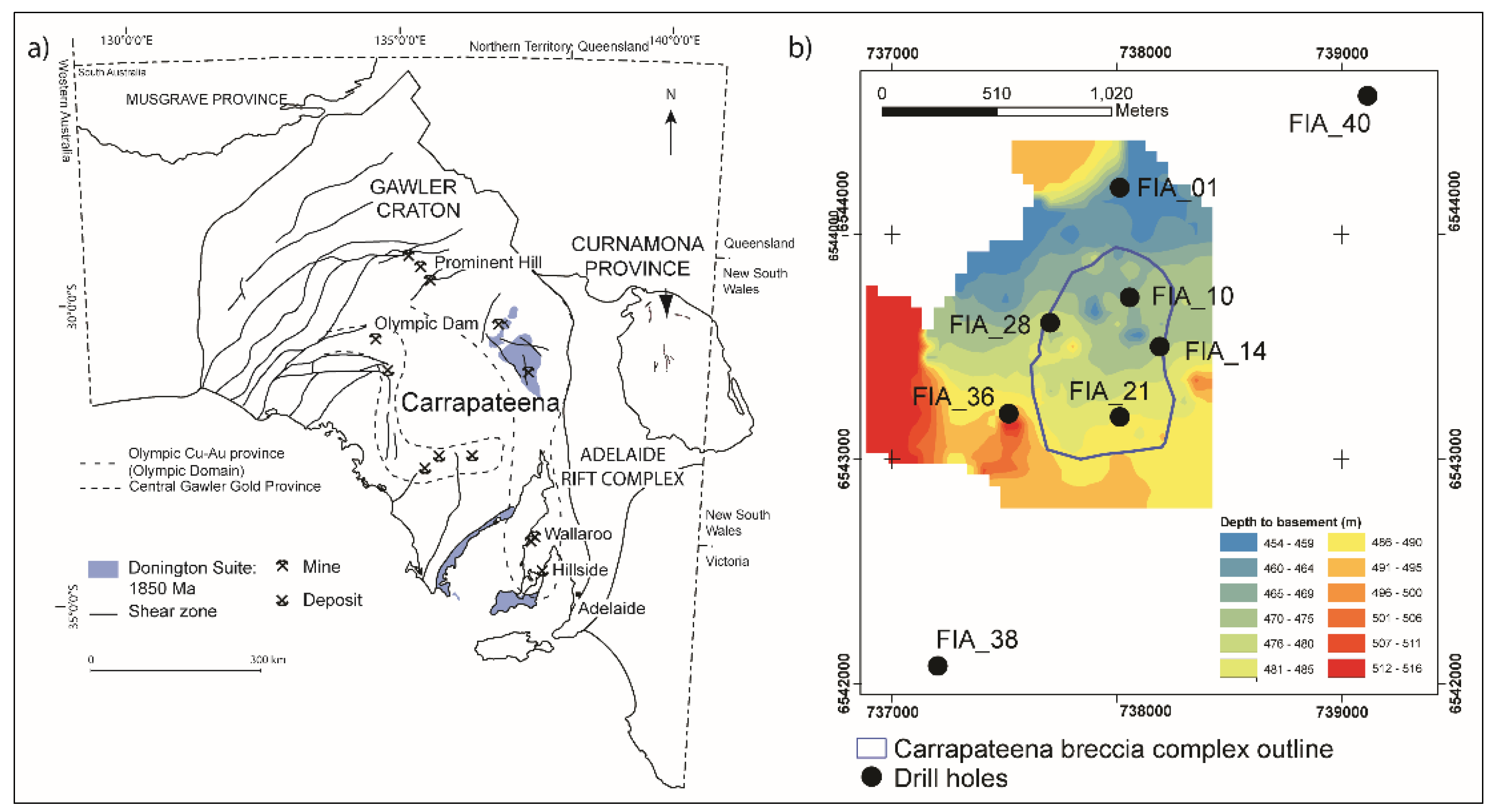
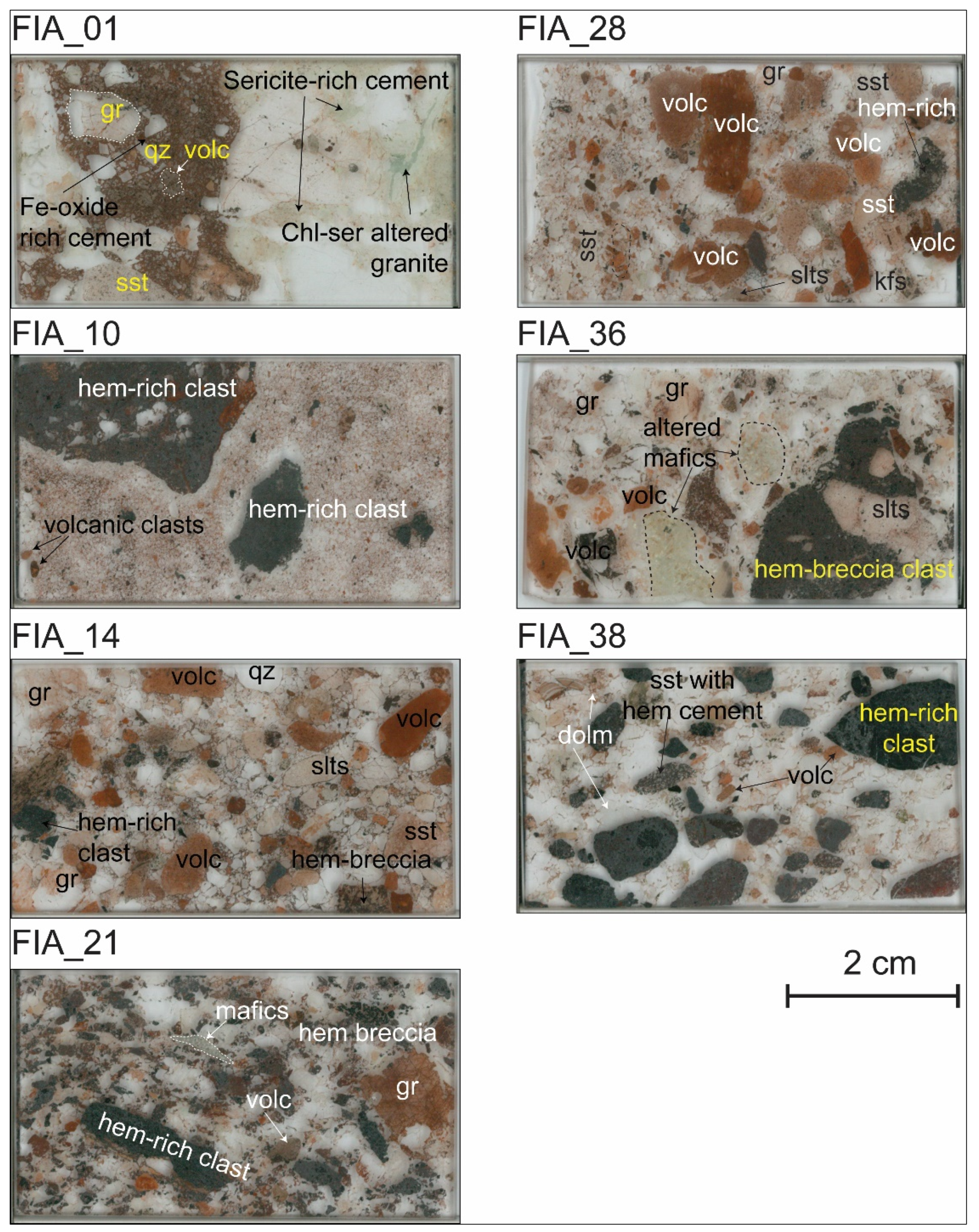
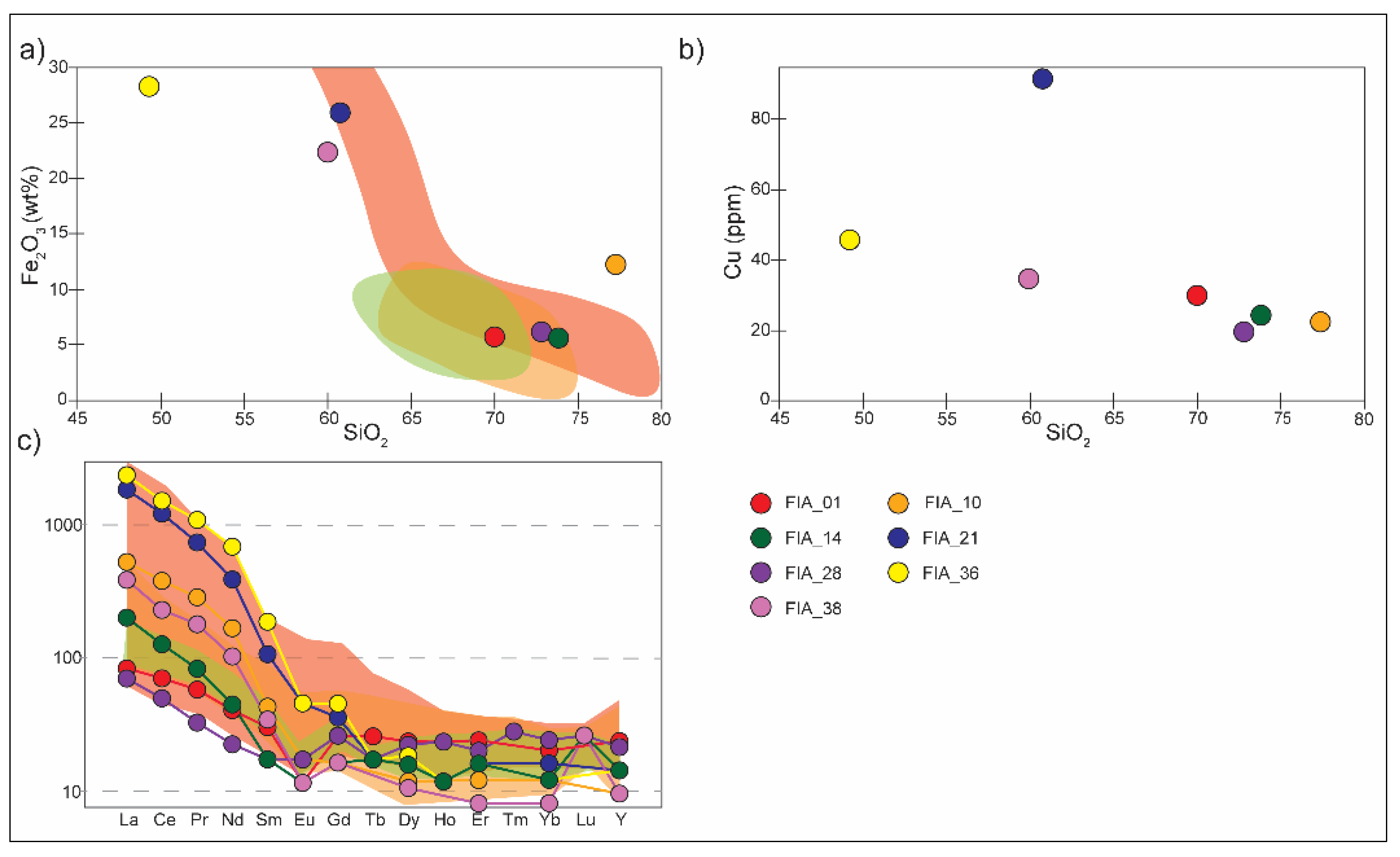
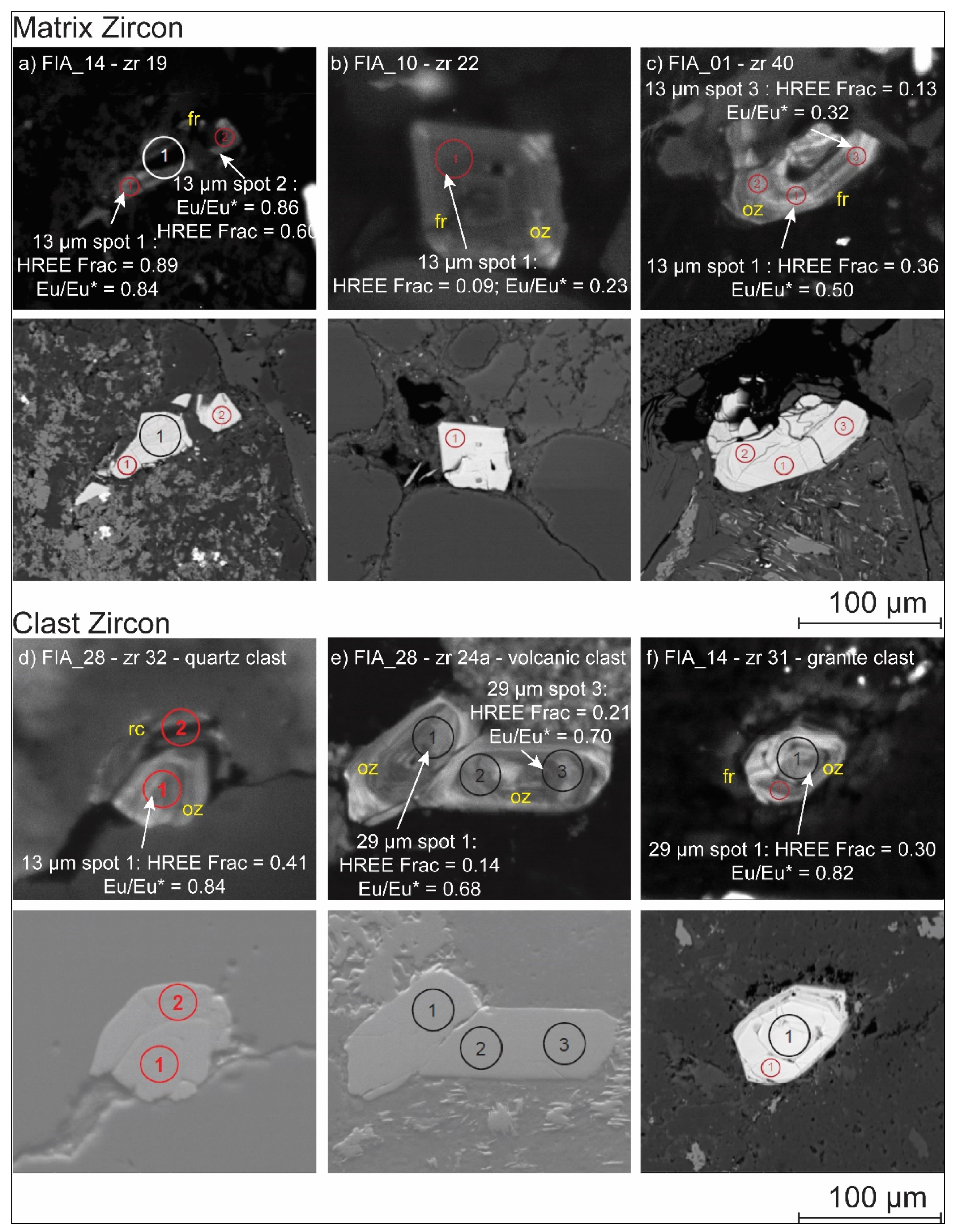
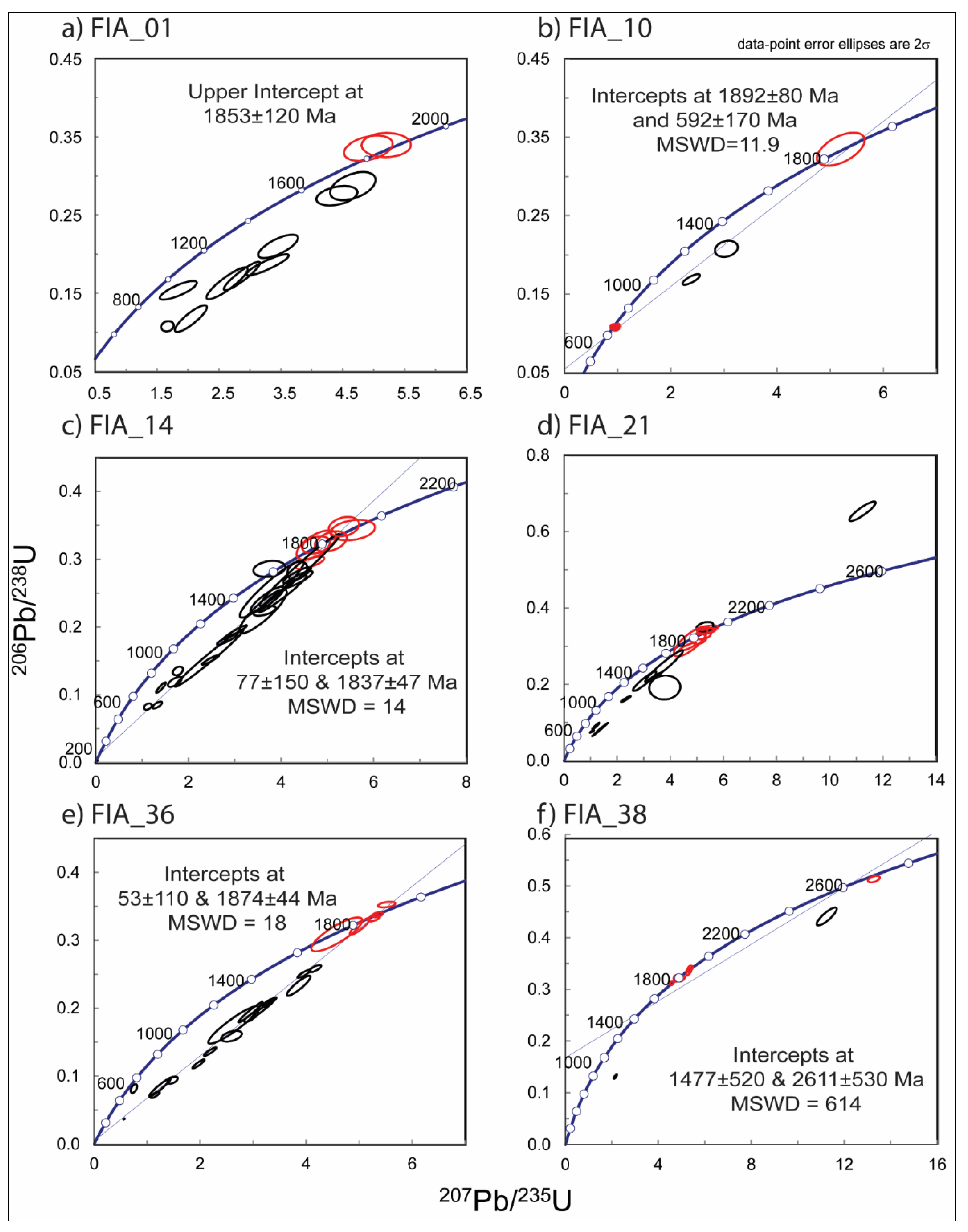
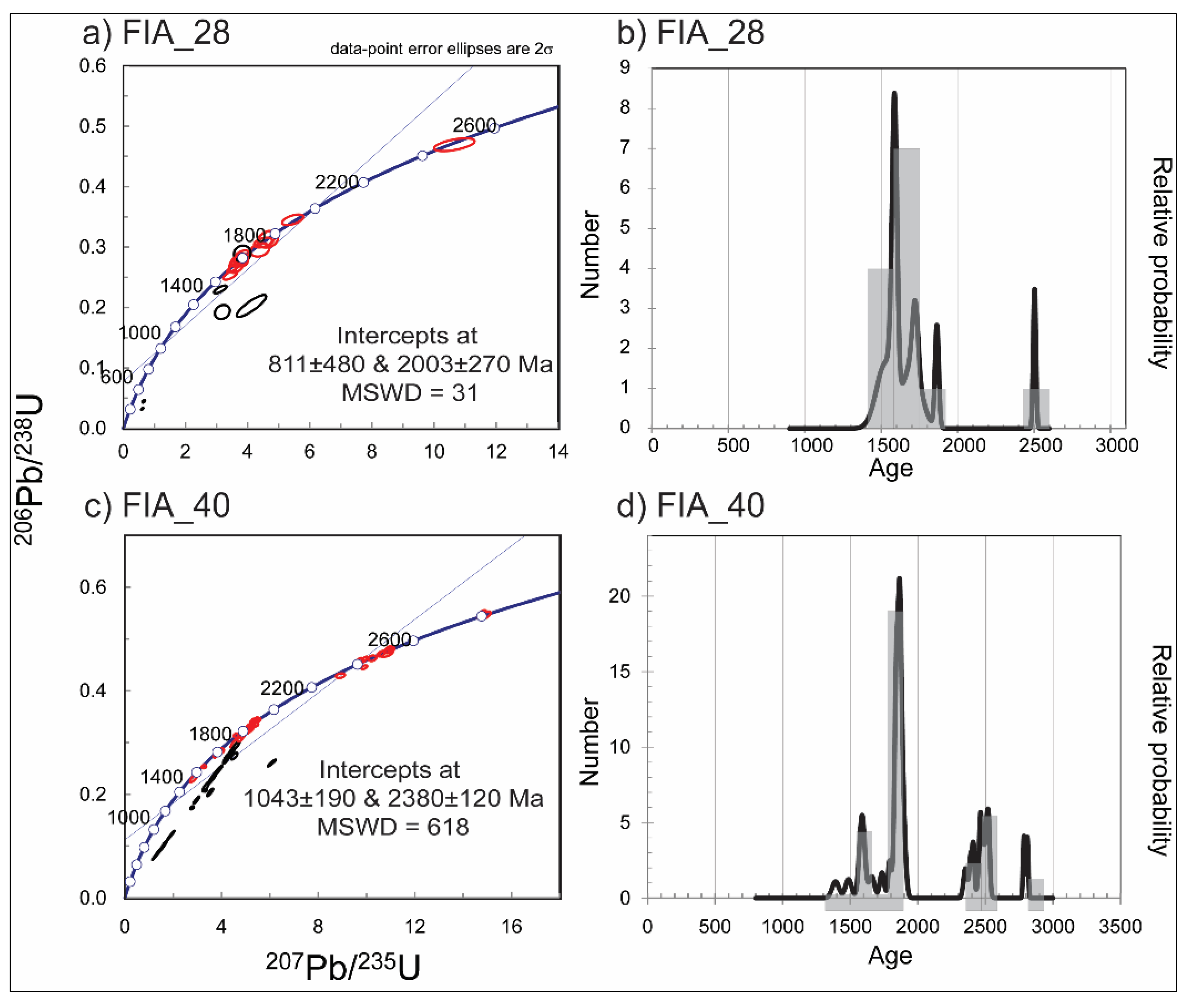
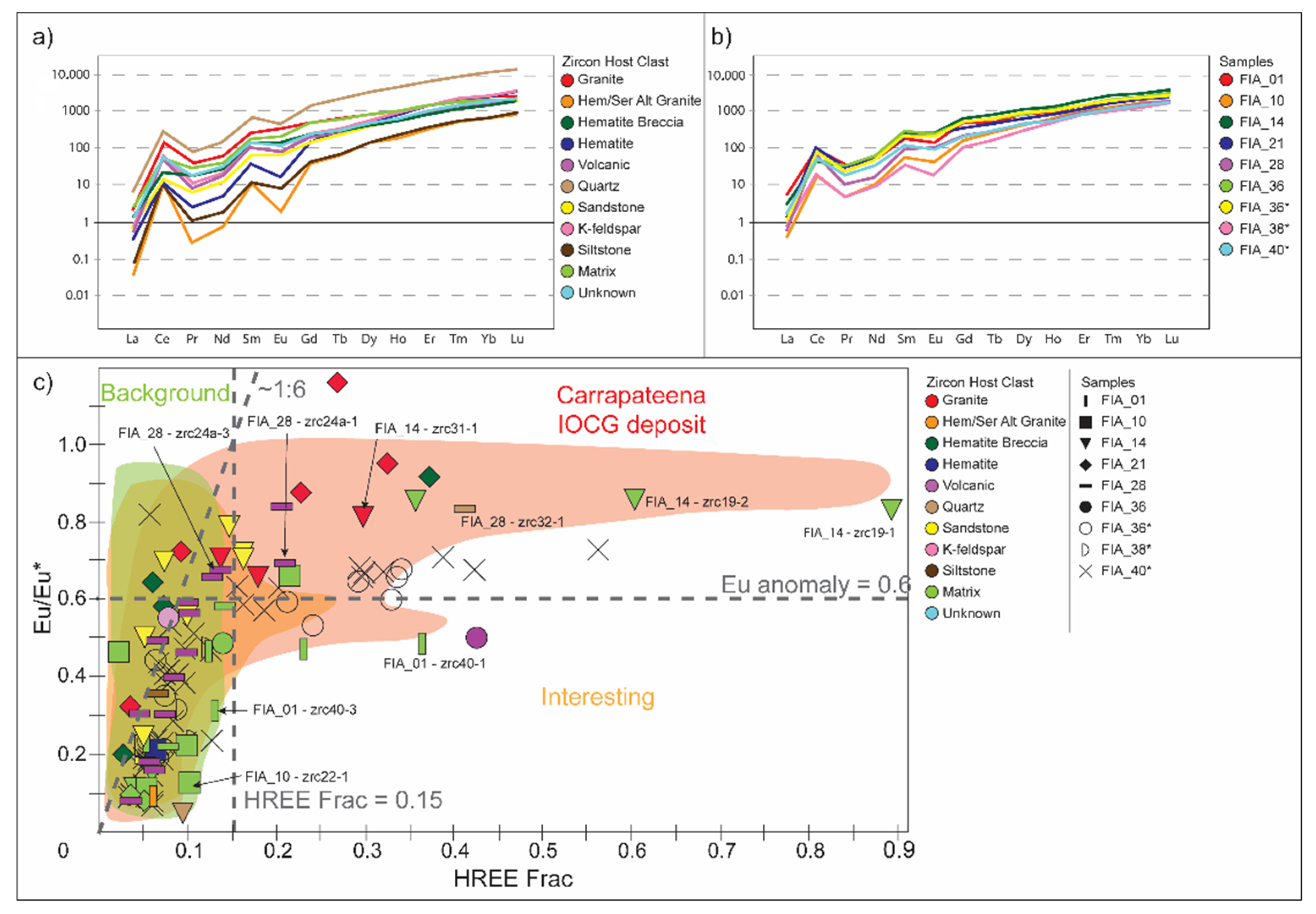
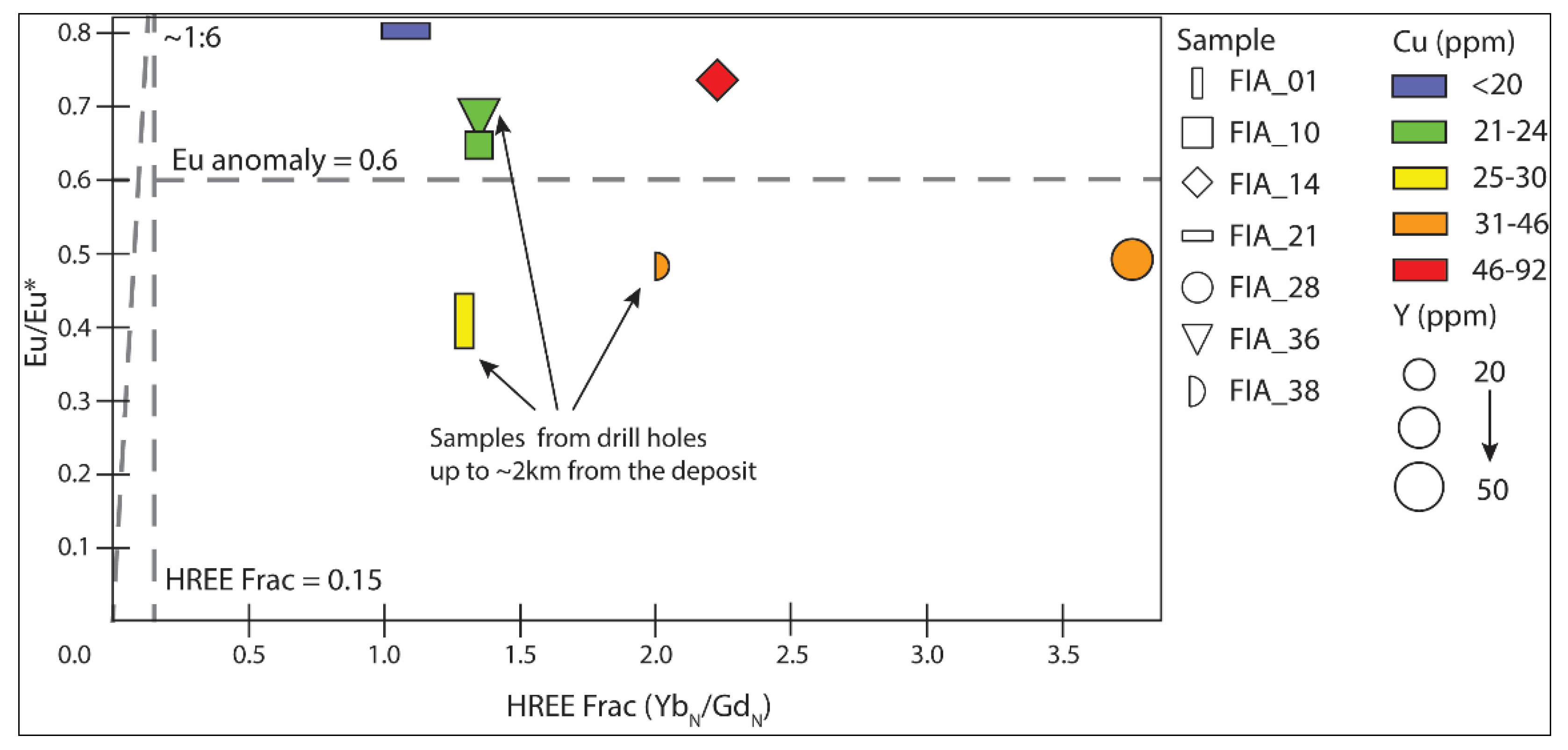
| Sample | Drill Hole | Number of Zircons | Sample Description | Zircon Location (Number of Analyses) | Interesting Zircon Geochemical Characteristics |
|---|---|---|---|---|---|
| FIA_01 | CAR010 (~1 km north of the orebody) | 6 | Matrix-supported, poorly sorted, polymictic diamictite. Matrix: fine–medium-grained, brown/reddish sandstone. Clasts: cobble sized, subangular to subrounded Fe-altered granite (~80–90%, up to 7 cm); well-rounded volcanic (~5%), sedimentary rock (~5%). | Matrix: (5); Clasts: Fe-altered granite (1) | Matrix: Heavy rare-earth element fractionation (HREE Frac) ≥ 0.15, Eu/Eu* ≤ 0.6. Clast: HREE Frac ≤ 0.15, Eu/Eu* ≤ 0.6. |
| FIA_10 | CAR019 | 6 | Matrix-supported diamictite. Matrix: medium-grained brown sandstone preserves chaotic bedding to planar laminated bedding. Clasts: angular to subrounded hematite, granite, quartz, mafic, and volcanic clasts. | Matrix: (5); Clasts: hematite (1) | Matrix: HREE Frac ≥ 0.15 Eu/Eu* ≥ 0.6. Clast: HREE Frac ≤ 0.15, Eu/Eu* ≤ 0.6. |
| FIA_14 | CAR058 | 14 | Poorly sorted, polymictic, clast-supported diamictite with rounded to subrounded quartz (~80%), K-feldspar (~5–10%), rounded, sericite-altered, volcanic clasts (~5%), well-rounded to angular granite (~5%), and angular hematite (~5%). | Matrix: (5); Clasts: sandstone (5), granite (3), quartz (1) | Matrix: HREE Frac ≥ 0.15, Eu/Eu* ≥ 0.6. Clast: HREE Frac ≥ 0.15, Eu/Eu* ≥ 0.6. |
| FIA_21 | CAR024 | 11 | Polymictic, clast-supported diamictite. Matrix: medium-grained, brown sandstone. Clasts: subrounded to subangular granite (~80%), mafics (<5%), volcanics (~15%), and quartz (<5%). | Matrix: (2); Clasts: granite (5), hematite breccia (4) | Matrix: HREE Frac ≤ 0.15, Eu/Eu* ≤ 0.6. Clast: HREE Frac ≥ 0.15, Eu/Eu* ≥ 0.6. |
| FIA_28 | CAR034 | 19 | Poorly sorted, polymictic, clast-supported diamictite. Matrix: brown, medium-grained sandstone. Clasts: well-rounded granite (up to 5 cm, up to ~40%), subangular hematite (~10%), mafic rock (angular, ~5%), hematite breccia (~2%), quartz (~15%), volcanic rock (~20%), other (different) types of granite (~10%). | Matrix: (2); Clasts: volcanics (14), sandstone (1), quartz (1), siltstone (1) | Matrix: HREE Frac ≤ 0.15, Eu/Eu* ≤ 0.6. Clast: HREE Frac ≥ 0.15, Eu/Eu* ≥ 0.6. |
| FIA_36 | CAR042 (~0.2 km west of the main orebody) | 13 | Well to moderately sorted, clast-supported, polymictic diamictite. Matrix: brown, medium-grained sandstone. Clasts: subangular to rounded Fe-, ser-altered (greenish tinge) granite (~40%), hematite breccia (~10%), quartz (~10%), volcanics (~40%), mafics (<5%). | Matrix: (1); Clasts: volcanics (1), K-feldspar (1), unknown host (10) | Unknown: HREE Frac ≥ 0.15 Eu/Eu* = Variable |
| FIA_38 | DD13CAR117W1 (~1km south-west of the main orebody) | 7 | Poorly sorted, clast-supported diamictite. Matrix: medium-grained sandstone. Clasts: well-rounded, pebble to boulder sized granite (~60-70%), angular hematite breccia clasts (~15%), itself containing visible altered granite and siltstone clasts, sericite-altered mafics with phenocrystic feldspar (~5%), well-rounded hematite-rich rock (~5%). | Unknown host (7) | Unknown: HREE Frac ≤ 0.15 Eu/Eu* < 0.6 |
| FIA_40 | CAR011 (~1 km north-east of the main orebody) | 40 | Poorly sorted, polymictic, clast-supported diamictite. Matrix: medium-grained sandstone. Clasts: medium to large pebbles of angular to subrounded hematite-rich clasts and altered granite. | Matrix: (5); Clasts: Fe-altered granite (1) | Unknown: HREE Frac ≥ 0.15 Eu/Eu* > 0.6 |
Publisher’s Note: MDPI stays neutral with regard to jurisdictional claims in published maps and institutional affiliations. |
© 2021 by the authors. Licensee MDPI, Basel, Switzerland. This article is an open access article distributed under the terms and conditions of the Creative Commons Attribution (CC BY) license (https://creativecommons.org/licenses/by/4.0/).
Share and Cite
Brotodewo, A.; Tiddy, C.; Zivak, D.; Fabris, A.; Giles, D.; Light, S.; Forster, B. Recognising Mineral Deposits from Cover; A Case Study Using Zircon Chemistry in the Gawler Craton, South Australia. Minerals 2021, 11, 916. https://doi.org/10.3390/min11090916
Brotodewo A, Tiddy C, Zivak D, Fabris A, Giles D, Light S, Forster B. Recognising Mineral Deposits from Cover; A Case Study Using Zircon Chemistry in the Gawler Craton, South Australia. Minerals. 2021; 11(9):916. https://doi.org/10.3390/min11090916
Chicago/Turabian StyleBrotodewo, Adrienne, Caroline Tiddy, Diana Zivak, Adrian Fabris, David Giles, Shaun Light, and Ben Forster. 2021. "Recognising Mineral Deposits from Cover; A Case Study Using Zircon Chemistry in the Gawler Craton, South Australia" Minerals 11, no. 9: 916. https://doi.org/10.3390/min11090916
APA StyleBrotodewo, A., Tiddy, C., Zivak, D., Fabris, A., Giles, D., Light, S., & Forster, B. (2021). Recognising Mineral Deposits from Cover; A Case Study Using Zircon Chemistry in the Gawler Craton, South Australia. Minerals, 11(9), 916. https://doi.org/10.3390/min11090916







